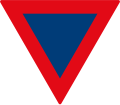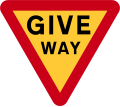
In road transport, a yield or give way sign indicates that merging drivers must prepare to stop if necessary to let a driver on another approach proceed. A driver who stops or slows down to let another vehicle through has yielded the right of way to that vehicle. In contrast, a stop sign requires each driver to stop completely before proceeding, whether or not other traffic is present. Under the Vienna Convention on Road Signs and Signals, the international standard for the modern sign is an inverted equilateral triangle with a red border and either a white or yellow background. Particular regulations regarding appearance, installation, and compliance with the signs vary by some jurisdiction.
Contents
- Terminology
- Areas where give way is used
- Areas where yield is used
- History
- Country specifics
- Australia
- Ireland
- New Zealand
- South Africa
- United Kingdom
- United States
- Other countries
- Gallery
- Signs with text in English
- Signs with text in Spanish
- Signs with text in other languages
- Signs with bilingual text
- See also
- Notes
- References
- External links































































